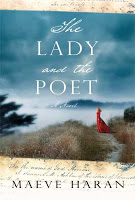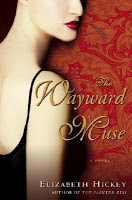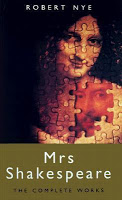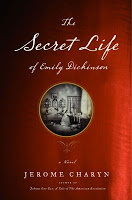Not much is known about Ann More, wife and inspiration of poet John Donne. Donne first met More in the home of her uncle and his employer, Thomas Egerton. Their union was opposed by her relatives and they married in secret. As a result, Donne spent some time in Fleet Prison until the validity of their marriage could be proven. Once released, his prospects diminished, they spent their lives in financial straits producing a large number of children. Ann Donne died young and Donne, unusual for a man with such a large family, never remarried. Maeve Haran speculates about the young woman who inspired and sustained such devotion in The Lady and the Poet.
 Ann More was not a typical fourteen year old of her time. In Elizabethan England, girls, like Ann’s sisters, were married to men who were advantageous family connections. If the girls were lucky, they survived childbirth and grew fond of their husbands. Ann was indulged by her grandfather and spent many happy hours reading, a highly unusual activity for such a young girl. In addition to, or perhaps as a result of, her unusual education, she was spirited and forthright. She deeply felt the early loss of her mother and older sister, making her all the more protective of those left behind. She was brave and bold and could not accept either a life at Court or an unhappy arranged marriage.
Ann More was not a typical fourteen year old of her time. In Elizabethan England, girls, like Ann’s sisters, were married to men who were advantageous family connections. If the girls were lucky, they survived childbirth and grew fond of their husbands. Ann was indulged by her grandfather and spent many happy hours reading, a highly unusual activity for such a young girl. In addition to, or perhaps as a result of, her unusual education, she was spirited and forthright. She deeply felt the early loss of her mother and older sister, making her all the more protective of those left behind. She was brave and bold and could not accept either a life at Court or an unhappy arranged marriage.
The Lady and the Poet is a rich portrait of the Elizabethan age and life at Court and its environs. This imaginative portrait is also a suspenseful page-turner as the story of these star crossed lovers unfolds. The story is interspersed with Donne’s metaphysical sonnets including, from Fleet Prison, the chastened – John Donne. Ann Donne. Un-done.
Other works of biographical fiction which come to mind are:
The Wayward Muse by Elizabeth Hickey
“I apologize again for my boldness, but I must tell you that you’re the most beautiful girl in Oxford. Maybe in all of England. I have to put you in my painting.” With these words, the scandalous, wildly talented painter Dante Gabriel Rossetti changes seventeen-year-old Jane Burden’s life forever. Jane’s gaunt, awkward figure and grave expression have cemented her reputation as the ugliest girl in Oxford. Raised by a stableman on Holywell Street — the town’s most sordid and despicable slum — Jane is nearly resigned to marry in-kind. But when she meets Rossetti at the theater, he sees beyond her worn, ill-fitting dress and unruly hair and is stirred by her unconventional beauty. The charismatic painter whisks Jane into Oxford’s exclusive art scene as his muse, and during the long and intimate hours of modeling — draping and tilting, gazing and posing — Jane finds herself falling in love.” – publisher
Mrs Shakespeare: the complete works by Robert Nye
“It is April 1594. Will Shakespeare, budding poet and playwright, invites his estranged wife to come to London to celebrate his thirtieth birthday. Seven years after his death, Anne Hathaway reminisces about her now-famous husband, recalling in particular that unforgettable week and what happened to her in a certain bed in his lodgings above a fishmonger’s shop-an enormous four-poster that the playwright called their “private playhouse.” By turns thoughtful and bawdy, Mrs. Shakespeare’s tale offers insight into Will’s secret lives, including the mystery of the second-best bed that he bequeathed her, as well as the question that has intrigued scholars and readers for centuries: to whom and for whom were the “Dark Sonnets” written” – publisher
The Secret Life of Emily Dickinson by Jerome Charyn
“The story begins in the snow. It’s 1848, and Emily is a student at Mount Holyoke, with its mournful headmistress and strict, strict rules. She sees the seminary’s blond handyman rescue a baby deer from a mountain of snow, in a lyrical act of liberation that will remain with her for the rest of her life. The novel revivifies such historical figures as Emily’s brother, Austin, with his crown of red hair; her sister-in-law, Sue; a rival and very best friend, Emily’s little sister, Lavinia, with her vicious army of cats; and especially her father, Edward Dickinson, a controlling congressman. Charyn effortlessly blends these very factual characters with a few fictional ones, creating a dramatis personae of dynamic breadth.” – publisher






